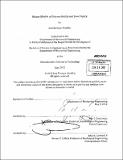| dc.contributor.advisor | Alan J. Grodzinsky. | en_US |
| dc.contributor.author | Avedillo, Jose Enrique | en_US |
| dc.contributor.other | Massachusetts Institute of Technology. Dept. of Mechanical Engineering. | en_US |
| dc.date.accessioned | 2012-10-26T18:07:47Z | |
| dc.date.available | 2012-10-26T18:07:47Z | |
| dc.date.copyright | 2012 | en_US |
| dc.date.issued | 2012 | en_US |
| dc.identifier.uri | http://hdl.handle.net/1721.1/74422 | |
| dc.description | Thesis (S.B.)--Massachusetts Institute of Technology, Dept. of Mechanical Engineering, 2012. | en_US |
| dc.description | Cataloged from PDF version of thesis. | en_US |
| dc.description | Includes bibliographical references (p. 39-40). | en_US |
| dc.description.abstract | Nearly 21 million Americans are affected by osteoarthritis, a complex disease characterized by degenerative lesions to the articular cartilage and subchondral bone in the joints. The complexity of the disease makes the use of human models impractical and complicated. Therefore, various animal models have been developed to study the progression of OA and possible therapeutic techniques. Of those models, mouse models play an integral part because of their cost-effectiveness, favorable logistics, and ability to be genetically manipulated. Three main mouse models were reviewed: (1) genetic deletion, (2) treadmill running, and (3) surgically induced injuries. Several strains of knockout mice have been develop in the past 10 years and they provide a great opportunity to study the evolution of OA. Up until now, treatment for OA has been pain management-related, but the development of more advanced mouse models has laid out the framework for possible OA preventing and repairing techniques. | en_US |
| dc.description.statementofresponsibility | by Jose Enrique Avedillo. | en_US |
| dc.format.extent | 40 p. | en_US |
| dc.language.iso | eng | en_US |
| dc.publisher | Massachusetts Institute of Technology | en_US |
| dc.rights | M.I.T. theses are protected by
copyright. They may be viewed from this source for any purpose, but
reproduction or distribution in any format is prohibited without written
permission. See provided URL for inquiries about permission. | en_US |
| dc.rights.uri | http://dspace.mit.edu/handle/1721.1/7582 | en_US |
| dc.subject | Mechanical Engineering. | en_US |
| dc.title | Mouse models of osteoarthritis and joint injury | en_US |
| dc.type | Thesis | en_US |
| dc.description.degree | S.B. | en_US |
| dc.contributor.department | Massachusetts Institute of Technology. Department of Mechanical Engineering | |
| dc.identifier.oclc | 813044784 | en_US |
